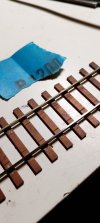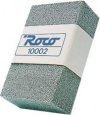paratom
Western Thunderer
Track cleaning, its something we all have to do if we have a layout but what is the best method. I recently was having a debate with my fellow modellers on this matter and as a rule they have always used a fine track rubber and isopropanol. Despite this tried and tested method it always takes a long time to get one of our layout tracks cleaned and ready for exhibition. I mentioned the use of fine wet and dry paper and was told this was a definite no as it leaves scratches on the rail. This evening I thought I would experiment on an old piece of copper clad track that is probably about 30 years old or more using P1200 wet and dry paper to see what sort of results I would get. The dirt came off with ease which I couldn’t say with the other method. Now what begs the question; did I damage the rail and leave scratches on it. Looking at the result I couldn’t see any visible scratches but then I didn’t have a microscope to examine the rail with. I’m sure that I would see some scratches under a microscope but would these be too small to have a detrimental effect on the rail. The 1200 paper is so smooth to touch I was surprised it took any dirt off at all. Your thoughts on this and what methods other modellers use to clean their tracks please.





